
The Basics:
- For ages 8 and up
- For 2 to 4 players
- Approximately 20 minutes to complete
Geek Skills:
- Counting & Math
- Logical & Critical Decision Making
- Reading
- Pattern/Color Matching
- Strategy & Tactics
- Risk vs. Reward
- Hand/Resource Management
Learning Curve:
- Child – Easy
- Adult – Easy
Theme & Narrative:
- Enter the Dragonwood and become an adventurer of great renown or a quick dragon’s meal
Endorsements:
- Gamer Geek rejected!
- Parent Geek approved!
- Child Geek approved!
Overview
Dragonwood is a large forest that lies south of the kingdom. Rumors say it’s a place of magic and danger that none should venture into. It was the home of the elves and their magic and power still remains. Which, of course, sounds awesome to any adventurer looking to get rich and make a name for themselves! Gather your party and venture forth! Here’s hoping you don’t get eaten…or worse.
Dragonwood, designed by Darren Kisgen and published by Gamewright, is comprised of 64 Adventure cards, 42 Dragonwood cards, 2 Turn Summary cards, and 6 custom six-sided dice. The game component quality is excellent, which is exactly what I have come to expect from Gamewright. The illustrations by Chris Beatrice capture the personality of each of the monsters and magical beats depicted on the cards, further strengthening the game’s theme and narrative with visual flair.
Getting Ready for Adventure
To set up the game, first separate the Adventure cards and the Dragonwood cards. Both card types will have different card back colors, making this a simple exercise.
Second, look through the Dragonwood deck (green backed cards) and remove the “Orange Dragon” and “Blue Dragon” Creature cards. Shuffle the Dragonwood deck and deal the top 8 to 12 cards to a pile, making certain not to reveal them to any player. The number of cards to be dealt is based on the number of players in the game. These cards are will not be used and can be placed back in the game box.
Third, shuffle both the Adventure deck and the Dragonwood deck. Split the Dragonwood deck in half and shuffle in the “Orange Dragon” and “Blue Dragon” Creature cards in the bottom half. Combine the two halves without shuffling the Dragonwood deck again, making certain the dragons are in the bottom half.
Fourth, deal each player 5 Adventure cards. This is the player’s starting hand. They should look at their cards, but keep them hidden from their opponents. Place the Adventure deck face-down in the middle of the playing area. Leave room for a discard pile.
Fifth, place the Dragonwood deck face-down below the Adventure deck and draw 5 Dragonwood cards, placing them face-up in a row. This row is referred to as the “Landscape”. If an Event card is drawn, shuffle it back in the Dragonwood deck and draw another card. Leave room next to the Dragonwood deck for a discard pile.
Sixth, place the Turn Summary and dice to one side of the game playing area.
That’s it for game set up. Decide which adventurer will enter the wood first to meet their destiny!
Welcome to Dragonwood
There are two primary card types in the game. These are Adventure cards and Dragonwood cards. Each card type has subtypes. I’ll summarize everything here, as players need to know how these cards interact and how they can be used for fun and profit.
Adventure Cards
There are 5 different Adventure card suits, with number values ranging from 1 to 12. Each of the five suits is meant to represent one of the 5 adventurers searching for gold and glory in Dragonwood. Each suit also has its own color. The portrayed adventurer’s class (warrior, wizard, etc.) has no impact to the game play.
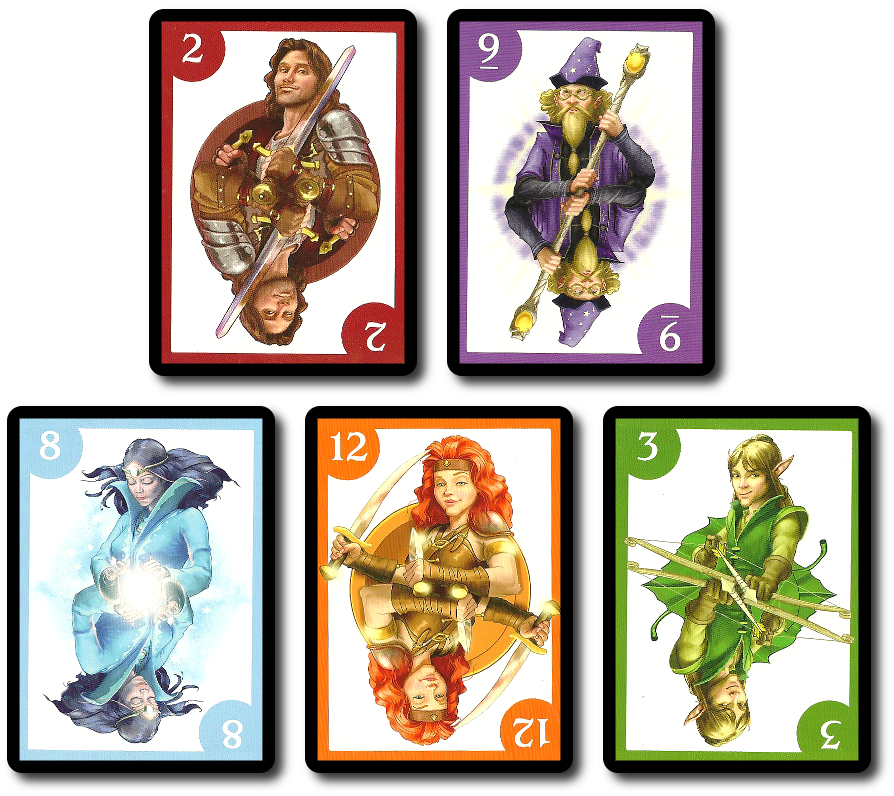
The Adventure deck also contains Lucky Ladybug cards. This card is not used to battle monsters (it’s a ladybug, after all), but they are as useful as a shield, spell, or sword. When drawn, they allow the player to draw more Adventure cards, increasing the player’s hand and chances of success.
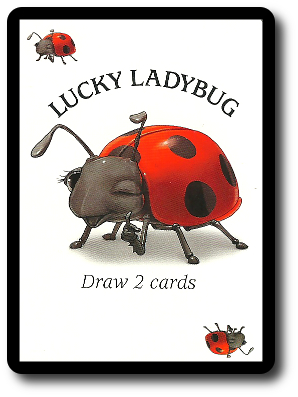
Dragonwood Cards
The Dragonwood deck contains everything the players will encounter within the ancient forest, including creatures and unforeseen events. The Event cards take effect as soon as they are revealed, temporarily pausing the game until they are resolved by all the players. The card’s instructions are read out loud and each player takes whatever action is required. The Event card is then discarded to the Dragonwood discard pile. After that, the active player continues to draw Dragonwood cards to refill the Landscape. If another Event should appear, the process is repeated.
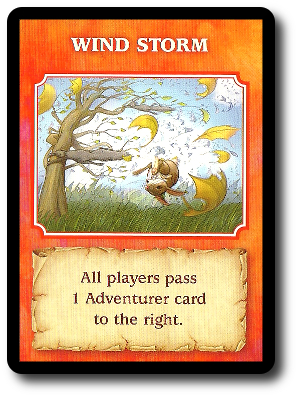
The Enhancement cards provide the player a benefit during the game, but are of no value at the end of the game. Most Enhancement cards are played in front of the player and remain active for the duration of the game. Powerful magic, indeed! There are some Enhancements, however, that can only be used once and are then gone. Regardless of how powerful the Enhancement might be, it must be won if it’s to be used. Nothing comes easy in Dragonwood.
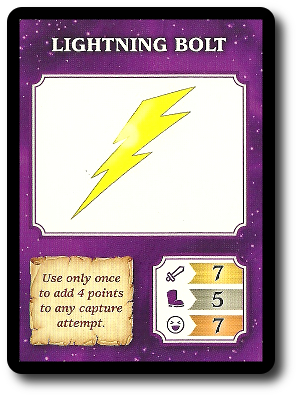
The Creature cards represent the wide variety of flora and fauna that live within Dragonwood. Most of them have teeth and like to bite. Hard. Players must defeat them if they hope to make a name for themselves and win the game. Each Creature card must be defeated using the player’s preferred method of combat, but the player will quickly note that some methods of combat are more effective than others. If the player wins the battle, victory and victory points are theirs! If not, they must retreat in defeat…and shame.
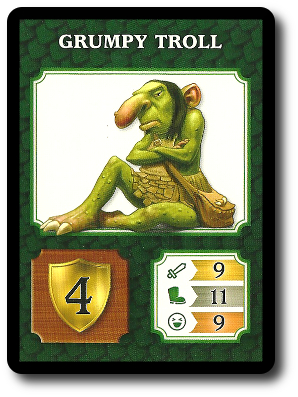
Deeper Into the Woods…
Dragonwood is played in turns. On a player’s turn, they can take 1 of 2 possible actions. These are “Reload” or “Capture”. Each is summarized here. If at any time the Adventure and Dragonwood decks are exhausted, shuffle the discard piles to form new draw decks.
Reload Action
This action allows the player to draw 1 Adventure card and add it to their hand. Thematically speak, the player is letting their adventuring party rest and regroup. If the player draws the Lucky Ladybug card, they discard the ladybug and draw 2 more Adventure cards.
If the player has 10 or more cards, they must now discard down to no more than 9. What cards the player discards is up to them. The player’s turn is now over. The next player in turn order sequence now goes.
Capture Action
This action allows the player to target 1 Dragonwood card in the Landscape and attempt to defeat it in battle. There are 3 different methods of combat. These are “Strike”, “Stomp”, and “Scream”. The method selected by the player determines 2 things. First, the type of hand the player must play. Second, the Capture value that the player must roll using dice. Needless to say, the player must now make a choice, but it’s not as hard as it might appear. Based on what Adventure cards the player has, the right way to battle the Creature card could be very obvious. In most cases, the stronger the Creature, the higher the victory points to be earned, making it easy to scan the Landscape for an easy target.
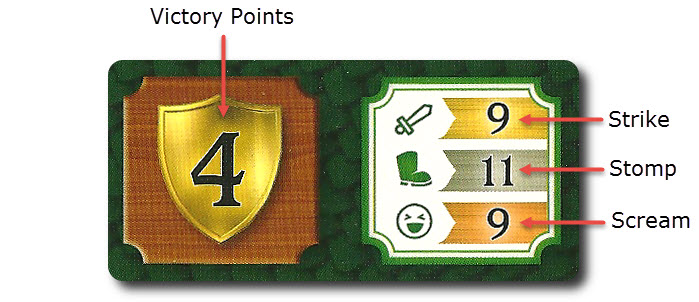
Within the context and narrative of the game, Adventure cards are considered “attacks”. The player will now be playing different sets of cards that represent these attacks. The required set or run is based on the player’s selected method of combat. No more than 6 cards can be played on a player’s turn. If the player believes it to be worthwhile, they can play only 1 card if they like, too.
The cards required for each method of combat are as follows:
- Strike: A numerical sequence of cards without any suit restrictions
- Stomp: Any number of cards with the same number value
- Scream: Any number of cards from the same suit (color) without sequential restrictions
After the player has selected their method of combat and played the correct cards, they grab 1 die for each card played. The player then rolls these dice to determine if their attack is successful. Dice values range from 1 to 4, with the values 2 and 3 appearing twice on the die.
If the combined value of all the dice and any Enhancements is equal to or higher than the Capture value associated with the player’s selected method of combat, the player takes the Creature card from the Landscape and places it in front of them, face-down. This is the player’s “Victory pile”. All the Adventure cards used are then placed in the Adventure card discard pile.
If the combined value of all the dice and any Enhancements is lower than the Capture value associated with the player’s selected method of combat, the player discards 1 of their played Adventure cards (consider it a “wound”), places the remaining Adventure cards back in their hand, and leaves the Creature card in the Landscape.
If the player is attempting to capture an Enhancement card, they select their method of combat, but do not get the benefit of any Enhancements they might have in play. Enhancements only work on Creature cards. If the Enhancement is captured, it’s placed in front of the player and the used Adventure cards are discarded. If the Enhancement is not captured, the player discards 1 Adventure card of their choice and keeps the rest.
The player then draws a new Dragonwood card and refills the Landscape to 5 cards if necessary, but does not refill their hand with Adventure cards. The player’s turn is now over and the next player in turn order sequence now goes.
End of the Adventure
The game continues with the players taking turns, taking one action per turn, until 1 of 2 possible conditions occur.
- The game ends immediately if both dragon Creature cards are defeated.
- The game ends after each player takes one last turn when the Adventure deck is exhausted for the second time.
All players now add up the victory points earned from the Creature cards placed in their Victory pile. The player who has the most Creature cards in their Victory pile is awarded a bonus of +3 victory points. If two or more players share the most Creature cards, they each receive +2 bonus victory points. The player with highest combined total wins the game. Ties are broken on total number of Creature cards in a player’s Victory pile.
Game Variant
A small number of game variants are provided for those who like to adjust their game play.
Dragon Spell
The “Dragon Spell” game variant adds a fourth method of combat that can only be used against a dragon Creature card. The player needs exactly 3 Adventure cards of the same color and in sequential order. This buys the player 2 six-sided dice (not 3). If the player rolls a combined dice total of “6” (along with any Enhancement bonuses) or higher against a dragon, the dragon is defeated. If the spell fails, the player must discard 2 Adventure cards instead of the normal 1 Adventure card.
Adjust Game Length
The length of the game can be altered fairly easily. For a shorter game, remove more Dragonwood cards than you would normally during game set up, making sure not to remove the dragon Creature cards. For a longer game, do not remove any Dragonwood cards during game set up and play until both dragons are captured.
House Rule
A number of our players didn’t like the fact that they could only attempt to capture one Creature per turn. We came up with a house rule that allowed players to capture twice per turn, but only if their first capture was successful. This resulted in most players capturing easy Creatures first and then attempting to capture harder Creatures second. This worked fairly well and challenged the players to think harder about what cards they would like to use and how much risk they were willing to take.
To learn more about Dragonwood, visit the game’s web page.
Final Word
The Child Geeks loved this game. They found the use of the cards to be intuitive, although they did need to refer to the Turn Summary cards often to refresh their memory concerning what constituted a Stomp, Strike, or Scream. They quickly learned that more cards played do not always result in a successful attempt to capture a card, but it certainly didn’t hurt. According to one Child Geek, “You have to think about how many cards you should play, but don’t play too many. Then you’ll run the risk of not being able to get good monsters in future turns.” Risk versus reward is a concept the Child Geeks have always been able to understand, but they oftentimes misjudge the amount of risk they are taking. Not the case in Dragonwood. As each card played represents a single die, the Child Geeks knew exactly what they were risking and what they would be losing. Another Child Geek said, “I really like this game for two reasons. First, it is just a lot of fun. Second, it makes you think.” All the Child Geeks voted to approve Dragonwood, finding it to be a game they really enjoyed.

The hand has been played and the dice are cast! Will luck be in the adventurer’s favor?
The Parent Geeks were also taken by the game for reasons similar to the Child Geeks. The Parent Geeks found the game to be a good mix of luck and strategy, of risk and reward, that challenged the player to make bold decisions and quickly laugh off failures. Luck plays a part in the game, but as the Child Geeks have already pointed out, the amount of luck in the game can be mitigated by doing some simple math. As one Parent Geek put it, “You always have a chance in the game, but not always a good chance of succeeding. I like that the game challenges you to take risk, but you can beat the game by simply removing luck from the equation.” Which you can do, but at a cost of playing a lot of cards. This is another aspect of the game the Parent Geeks enjoyed. With a hand size limit and a limit to the number of cards that can be played, one must manage their hand if they want to reduce their dependency on the dice. As one Parent Geek said, “The cards are like your equipment. You don’t want to go into the woods without the right gear.” All the Parent Geeks found Dragonwood to be a game that was enjoyed at their family gaming table and among their peers. Its casual game play masked a level of critical thinking and risk taking that coiled just below the surface like the dragons in the game.
The Gamer Geeks, for the most part, enjoyed themselves, but few found it to be an engaging game. As one Gamer Geek put it, “I like this game and what it is doing, but it’s not a game for me. Feels more like a family or a kid game. Solid, though, and well thought-out.” Another Gamer Geek said, “I like it and think it would be a great game for casual play and fillers. It’s certainly a game I would play in mixed groups, but I don’t know if I would play it only with Gamer Geeks.” At the heart of the issue, and what kept many Gamer Geeks from loving the game fully, was how straight forward the game was. There are choices to be made, but they are few. For gaming elitists, the choices were always obvious, resulting in a game that didn’t challenge them. They gave Dragonwood full marks for being good, but could not approve it for Gamer Geeks.
Dragonwood has something for everyone. Strategy, tactics, bluffing, hand management, risk taking, and critical decision making can all be found within the game, but Dragonwood lacks the depth of play Gamer Geeks crave. The game is delivered in a way that makes it very accessible and enjoyable for the Child Geeks, but still challenging enough to keep more skilled players interested for a game or two. With a few exception, everyone who played it enjoyed it.
For those who did not enjoy the game, it was obvious why. Dragonwood is light, despite the choices the player will have to make in the game that don’t have easy answers. The goal is always the same. Either collect the Creature with the most victory points or go for the easy kill and hope you have enough points to win the game. Both paths have their pros and cons, but there is no real middle road to travel. Still, the game is engaging and keeps the players focused on the goal. No one really knows who will win until the end, which keeps the energy level at the gaming table at a constant high and invites opponents to bluff others to take unnecessary risks.
My favorite part of the game is that there was always something to do. Players could attempt to defeat a Creature, even if they only had 1 Adventure card, for example. The option was there, as if the game was daring the player to take a swing at it. Which they did. Near misses were met with the same enthusiastic cheers and groans as lucky hits. All the players leaned forward when the dice were rolled and enthusiastically scanned the Landscape for Creatures and Enhancements.
I was most pleased with Dragonwood. The fantasy theme is present throughout without overpowering the game play. The level of thought necessary to compete and win is slightly higher than your average casual game, but still well within the limits of all our players. The only aspect that kept getting in the way was the fickle dice that sometimes rolled the way you wanted and sometimes didn’t, despite addressing all possible risks.
Do play a game or two of Dragonwood when the opportunity presents itself. As a family, casual, and filler game, I believe it does a great job. It lacks the teeth the elitist Gamer Geeks were hoping for, but the game still has a bite. Watch yourself.
This game was given to Father Geek as a review copy. Father Geek was not paid, bribed, wined, dined, or threatened in vain hopes of influencing this review. Such is the statuesque and legendary integrity of Father Geek.




You say, “If the player believes it to be worthwhile, they can play only 1 card if they like, too.”
I am really curious about this rule. Did you read this in the directions? It would be helpful to know because I was not sure whether you needed and actual run of (3) because that is how most card games work, example being Rummy.
I have been playing with runs of (2), but if I could play with just (1), and then declare which combat I am initiating, that would be great!
Please let me know.
Thanks for taking the time to read the review and leave a comment, Dan.
The rules do not specify how many cards are required, but we can infer from the number of dice in the game that a play with a minimum of 1 card will allow the player to roll 1 die. Likewise, there are only 6 dice in the game, meaning playing anymore than 6 cards is unnecessary (unless including Enhancement cards). The visual examples provided do show 3 or more cards being played, but these should not suggest the required number of cards. You play more cards to use more dice and improve your odds. A player can play as many cards as they like or as few.
My interpretation, of course. I encourage you to contact Gamewright directly if you would like to know with absolute certainty.
Great! Thanks for the insight. It has been a fun game to play with my young boys!
Cyrus is correct. You may only use 1 card for an attack if you choose. Glad you are enjoying the game Dan!
Great to hear it straight from the designer! Thanks!
One minor flaw in the game rules: you can get into a stalemate where players don’t want to capture any cards for fear of revealing higher-value replacements for their opponents to capture. This occurs if all players have “powerful” hands and can defeat most creatures, the landscape is populated with low-value conquests, you’re near the end of the game and know there are dragons and/or other high-value cards left in the deck, We’ve often got to this stage with two players (junior @ 7 yo.)
An excellent point, Andy, and a situation I am all too familiar with. Try our House Rule that allows players to capture twice. The first capture attempt is played out as normal. If it is successful, the player can attempt to capture again. We found that most players will take out an easy target to ensure they can capture a second time.
We shall take that rule to battle as soon as junior gets home from school